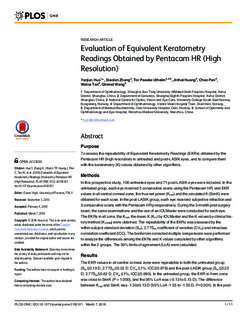| dc.description.abstract | PURPOSE: To assess the repeatability of Equivalent Keratometry Readings (EKRs) obtained by the Pentacam HR (high resolution) in untreated and post-LASIK eyes, and to compare them with the keratometry (K) values obtained by other algorithms. METHODS: In this prospective study, 100 untreated eyes and 71 post-LASIK eyes were included. In the untreated group, each eye received 3 consecutive scans using the Pentacam HR, and EKR values in all central corneal zone, the true net power (Knet) and the simulated K (SimK) were obtained for each scan. In the post-LASIK group, each eye received subjective refraction and 3 consecutive scans with the Pentacam HR preoperatively. During the 3-month post-surgery exam, the same examinations and the use of an IOLMaster were conducted for each eye. The EKRs in all zone, the Knet, the mean K (Km) by IOLMaster and the K values by clinical history method (KCHM) were obtained. The repeatability of the EKRs was assessed by the within-subject standard deviation (Sw), 2.77Sw, coefficient of variation (CVw) and intraclass correlation coefficient (ICC). The bonferroni corrected multiple comparisons were performed to analyze the differences among the EKRs and K values calculated by other algorithms within the 2 groups. The 95% limits of agreement (LoA) were calculated. RESULTS: The EKR values in all central corneal zone were repeatable in both the untreated group (Sw≦0.19 D, 2.77Sw≦0.52 D, CVw≦1%, ICC≧0.978) and the post-LASIK group (Sw≦0.22 D, 2.77Sw≦0.62 D, CVw≦1%, ICC≧0.980). In the untreated group, the EKR in 4mm zone was close to SimK (P = 1.000), and the 95% LoA was (-0.13 to 0.15 D). The difference between Knet and SimK was -1.30±0.13 D (95% LoA -1.55 to -1.55 D, P<0.001). In the post-LASIK group, all the EKRs were significantly higher than KCHM (all P<0.001). The differences between the EKR in 4mm zone and KCHM, the EKR in 7mm zone and KCHM, Knet and KCHM, Km and KCHM, SimK and Knet were 0.64±0.50 D (95% LoA, -0.33 to 1.62 D), 1.77±0.88 D (95% LoA, 0.04 to 3.51 D), -0.98±0.48 D (95% LoA, -1.92 to -0.04 D), 0.64±0.53 D (95% LoA, -0.40 to 1.68 D), and 1.73±0.20 D (95% LoA, 1.33 to 2.13 D), respectively. CONCLUSIONS: The EKRs obtained by the Pentacam HR were repeatable in both untreated eyes and post-LASIK eyes. Compared to the total corneal power obtained by the clinical history method, the EKR values generally overestimated the total corneal power in post-LASIK eyes. So, further calibrations for the EKR values should be conducted, before they were used for the total corneal power assessment in post-LASIK eyes. | nb_NO |

